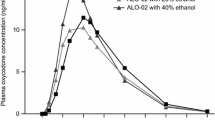Abstract.
Objective: To determine the cardiovascular, subjective effects and potential of abuse liability of single dose (–) ephedrine (E) administered orally (50 mg) or intranasally (10 mg and 5 mg). Methods: Sixteen healthy Caucasian men with no history of drug/alcohol/nicotine abuse or dependence received intranasal single doses of E 5 mg, 10 mg and oral doses of 50 mg and placebo in a double-blind, double-dummy, crossover study. Dependent measures included assessment of subjective feelings by Addiction Research Centre Inventory (ARCI), Profile of Mood States (POMS), visual analogue scales (VAS); "drug liking", "any drug effect", subjective quality of sleep and blood pressure and heart rate. Plasma E concentrations were also determined. Results: (–) E increased supine systolic, diastolic blood pressure (P<0.01). Changes in supine systolic blood pressure (areas under the 8 h of the experimental sessions) were –59±47 mmHg·h with placebo, –59±57 mmHg·h with E 5 mg by the nasal route, –18±48 mmHg·h with E 10 mg by the nasal route and 13±58 mmHg·h with E 50 mg by the oral route (P<0.001). (–) E-induced orthostatic hypotension (P<0.01) (maximal systolic blood pressure drop: E 50 mg 14±10 mmHg, P<0.03; E 10 mg 11±6 mmHg, P=0.08 compared with placebo) and resulted in decreased tiredness (placebo –2±39 mm·h, E 5 mg –17±39 mm·h, E 10 mg –30±42 mm·h, E 50 mg –24±35 mm·h; P<0.03). E did not modify ARCI subscales – in particular the "amphetamine" subscale – but showed a tendency for drug liking (P=0.09). On the "any drug effect" questionnaire, subjects could identify drug effect (P=0.007). Maximal plasma E concentration (Cmax) and areas under the curves for up to 8 h were proportional to the doses. Elimination half-life was approximately 6 h. A clockwise hysteresis was observed for systolic blood pressure in all but one subject with E 50 mg by the oral route. Conclusion: E even at low doses and by the nasal route can decrease tiredness in healthy persons; this is accompanied by a substantial increase in blood pressure and orthostatic hypotension exposing individuals in case of intensive physical exercise to cardiovascular risks. No clear evidence of abuse liability in healthy drug naive subjects was observed.
Similar content being viewed by others
Author information
Authors and Affiliations
Additional information
Accepted in revised form: 1 May 2001
Electronic Publication
Rights and permissions
About this article
Cite this article
Berlin, I., Warot, D., Aymard, G. et al. Pharmacodynamics and pharmacokinetics of single nasal (5 mg and 10 mg) and oral (50 mg) doses of ephedrine in healthy subjects. Eur J Clin Pharmacol 57, 447–455 (2001). https://doi.org/10.1007/s002280100317
Received:
Issue Date:
DOI: https://doi.org/10.1007/s002280100317




